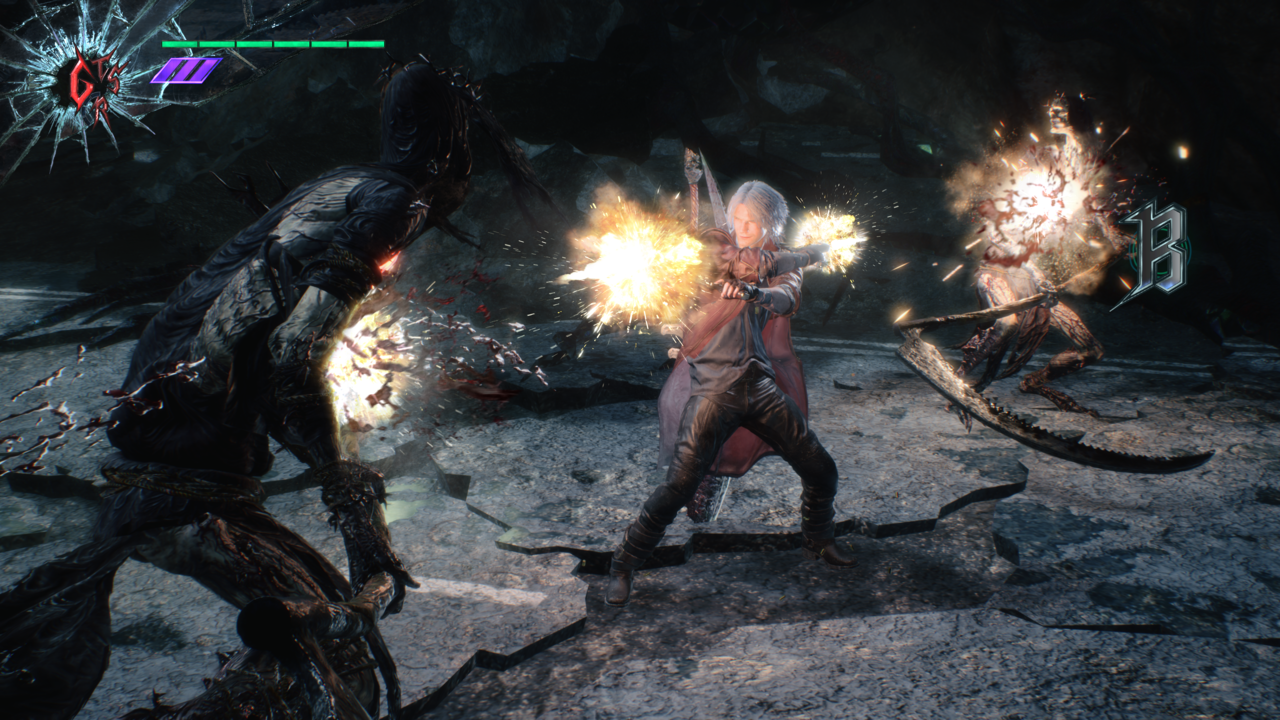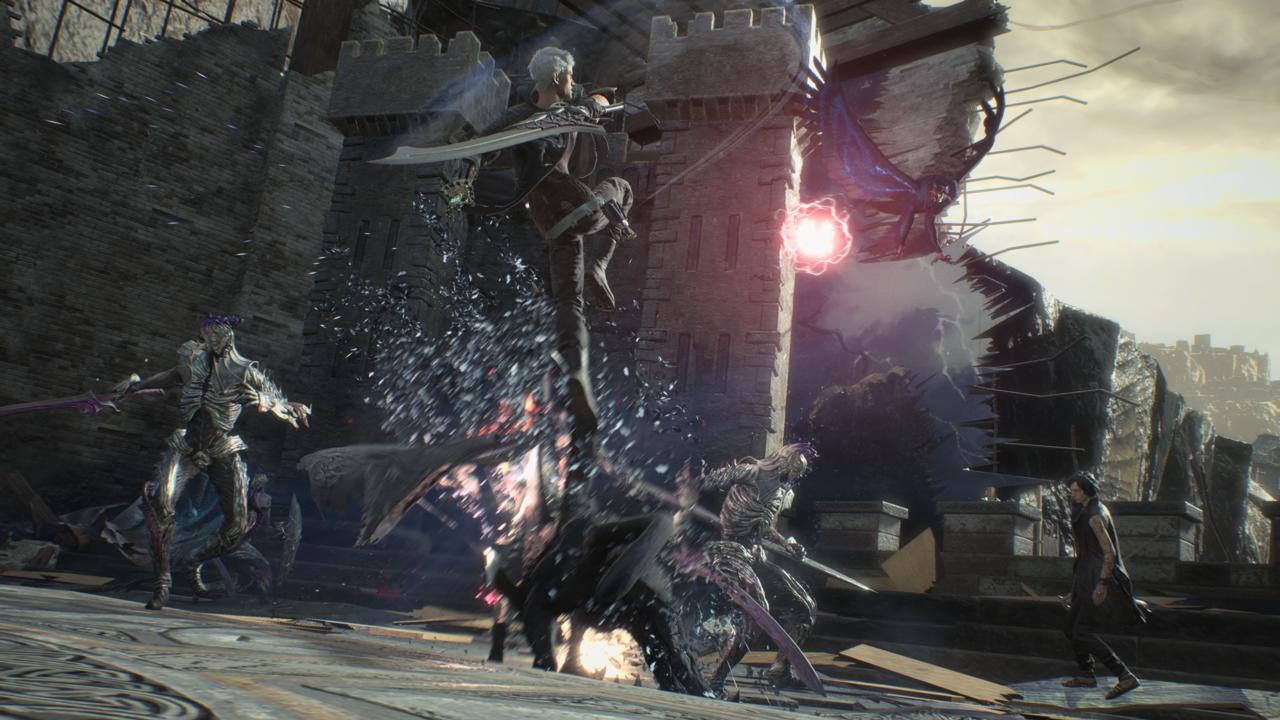After spending a few hours playing Devil May Cry V, the joints in my fingers were aching and my wrist was cramped. These pains should be familiar to Devil May Cry fans; the series always required a high level of dexterity. But in this sorry state, a simple joy washed over me: "I'm actually playing a new Devil May Cry game, and that's awesome." But at the same time, another thought prodded my mind: "Will everyone else want this?"
DMCV is a return to not only the series' previous canon, but to the philosophy and near fighting game-like intricacy of the first four games. As a longtime fan, it was exhilarating to play Nero and Dante again, slowly learning the strategic nuances of their every move, while constantly trying to better my execution. The high skill ceiling taunted me, instigating a deep desire to better understand how Nero's Devil Breaker arms work, and to finally master seamlessly switching between Dante's four different fighting styles. [Update: Read on for our early impressions, or check out our final Devil May Cry V review.]

While I'm confident hardcore fans will love the work that's been done with combat in DMCV, the level design in between combat sections leaves much to be desired. This is where I find myself second guessing what the game is doing. There are some lessons from DmC: Devil May Cry that haven't been learned from here. Say what you will about the polarizing reboot, but that game presented some incredibly interesting level design and provocative visuals; showcasing diverse and compelling environments (sans the edgy text displayed on walls).
In DMCV, you're typically running through ruined city streets and dilapidated buildings infested by thorny roots from a massive demonic tree at the center of town. A mission in the aforementioned tree helped break things up, but interesting sights like this were quickly overrun by more of the same apocalyptic backdrops. The repetition wore me down, especially when I started to realize that progression outside fights could be narrowed down to "destroy this red sack on this root, open path, repeat." It made me yearn for the chaotic highs of air juggling demons and subsequently breakdance-fighting their friends into oblivion.

If not for DMCV's fantastic combat, this issue would be more troublesome. But it got me thinking: does this problem exist because classic DMC games are designed with a different philosophy in mind? While I can't answer this question myself, all I know is that the innovation of the combat system is what keeps me eager to return to DMCV.
Newcomer V is an excellent example of this innovation; his ranged playstyle is probably the most creative and refreshing part of DMCV so far. You use V's summoned beasts to damage enemies for you, while you stand back and wait for the moment to deliver the final blow after their life has been depleted. It's all about space management and calculated movement; you need to be mindful of enemies around you, as a dodge in any direction will instantly call back one of his summons from the fray for a brief duration. Cunningly avoiding attacks as you command your beasts to deliver complex juggles provides a satisfying thrill. It's made all the more rewarding by the impact of a final blow alongside V's goading remarks. V's fighting style defies the directly offensive strategies of previous playable characters, but it's one that still feels right at home with the series. He's where I feel DMCV's combat design expresses itself the most, innovating and rearranging what we know from past games.
Metaphor: ReFantazio The King’s Trial Trailer Tales of the Shire - Official Announcement Trailer Dead Island 2 – Steam Launch Trailer Nickelodeon All-Star Brawl 2 - Official Zuko Gameplay Spotlight Trailer Valheim: Ashlands - Official Gameplay Trailer Tales of Kenzera: ZAU GameSpot Video Review Stellar Blade - Beta Skills Gameplay Trailer | PS5 Games Stellar Blade - Burst Skills Gameplay Trailer | PS5 Games GODDESS OF VICTORY: NIKKE | New Main Chapter 29~30 Update Trailer GODDESS OF VICTORY: NIKKE | Happy 1.5 Anniversary Trailer GODDESS OF VICTORY: NIKKE | Kilo Character Motion Demonstration Trailer How The Fallout TV Show Shapes Fallout's Future
Please enter your date of birth to view this video
By clicking 'enter', you agree to GameSpot's
Terms of Use and Privacy Policy
There are hints of previous mechanics all around, but refinements and alterations have brought new life to them. V's playstyle calls to mind the tactics spurred by Vergil's concentration gauge from DMC4: Special Edition, where minimal movement and calculated attacks are key. On the other hand, Nero's various Devil Breakers significantly evolve his playstyle by adding more offensive options in a fight. You can propel a foe across the screen with the Overture's powerful attack, but in short time, detonate it in another group of demons while switching over to the Punch Line, riding it like a rocket-propelled skateboard into those still left alive. A great degree of technical skill is introduced to Nero thanks to the Devil Breakers, making his once beginner-friendly playstyle more complex than ever before.
Dante is the only character who seems to remain faithful to previous iterations with few adjustments made to his base abilities--but maybe that's the point. With all the new mechanics introduced with Nero and V, Dante maintains the series' tradition, confidently declaring that everything you remember from the classic DMC combat system is back. That said, I only had access to a few of the weapons in his arsenal, so it's possible even he may change as you progress further in the full game.

It's difficult to balance my expectations for DMCV. The more experimental DmC: Devil May Cry inspired me to think more deeply about what a game in the series could be, calling upon a higher standard for its accessibility and design overall. But my time with DMCV brought back memories of my infatuation with the story and combat of early games. Dante sports that same endearing confidence that charmed my teenage heart all those years ago. Nero maintains the brashness of DMC3 Dante that I love; though, a new outlook reduces his once angsty demeanor. And with the innovation and creativity present in combat, I can't help but look past my greater dreams of what DMC's structure could be and simply accept DMCV for the traditional experience it is. If that means newcomers being further alienated from one of my favorite series of all time, then that might be a reality I have to accept. My fondness for the series in this form is simply too strong to want it any other way.
When DmC: Definitive Edition and DMC4: Special Edition both launched in 2015, the franchise was at a crossroads. After playing both, I realized that the series can honestly be one or the other and still be phenomenal. Before going to this event, I anticipated Capcom would make DMCV a hybrid of both, but in the end it chose one: classic DMC.





















